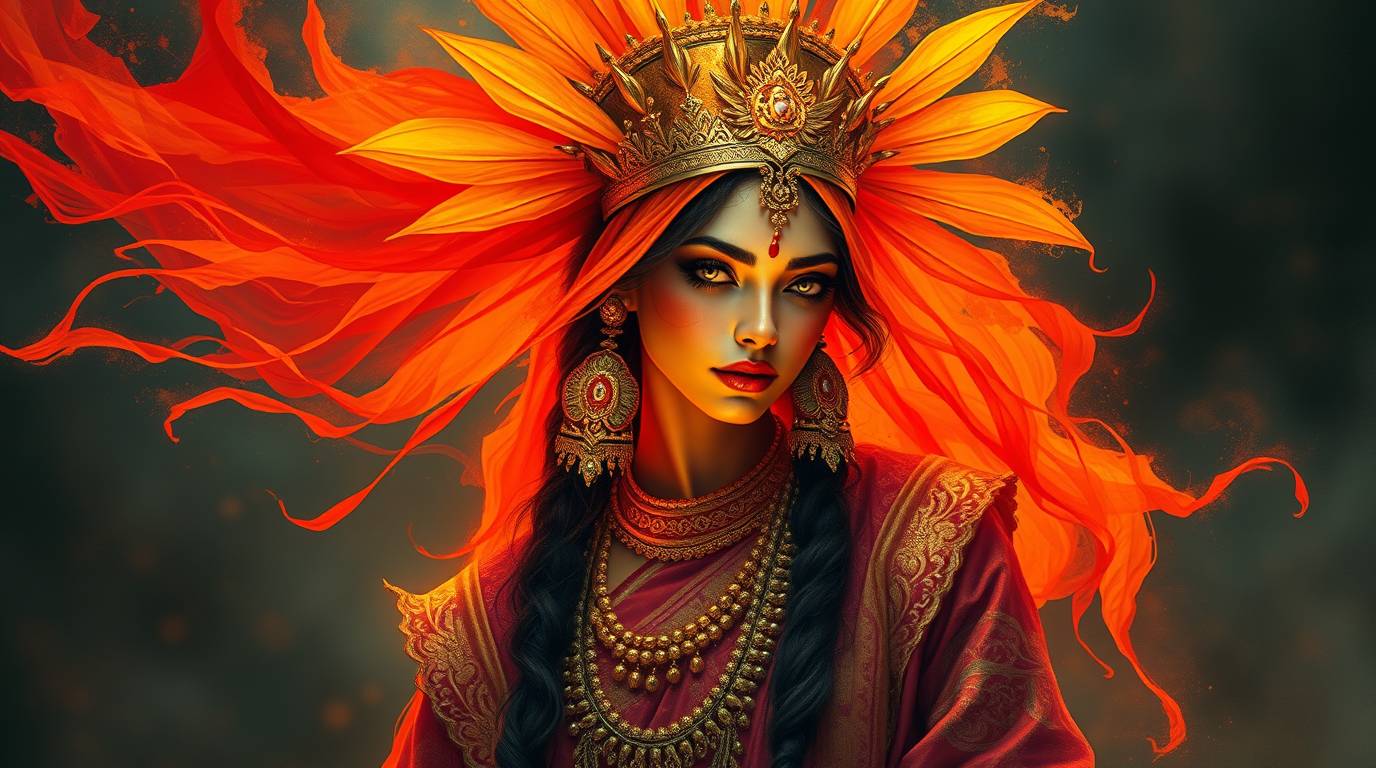Who Are Yakshinis (यक्षिणी)? Powers, Types, and Their Impact on Human Life
India’s rich spiritual traditions speak of many divine and semi-divine beings. Among them, Yakshinis (or Yakshis) are enigmatic female spirits or deities believed to influence human life in both positive and negative ways. While often associated with beauty, wealth, and mysticism, their dual nature as protectors and seducers raises a common question—are Yakshinis good or bad for humans?
This in-depth guide explores who Yakshinis are, how many types of Yakshinis exist, their spiritual roles, and how they interact with human beings in traditional Hindu and Tantric belief systems. Whether you’re researching ancient Indian deities, spiritual entities, or seeking esoteric knowledge, this article covers all aspects of the mysterious world of Yakshinis.
Table of Contents
- Meaning and Origin of Yakshinis
- Are Yakshinis Divine or Demonic?
- Role of Yakshinis in Hindu and Tantric Practices
- The Connection Between Yakshinis and Yakshas
- How Many Yakshinis Are There?
- The 36 Most Known Yakshinis and Their Powers
- Can Yakshinis Help or Harm Humans?
- Yakshini Sadhana: Worship and Invocation
- Warnings, Risks, and Guidelines
- Yakshinis in Ancient Temples and Sculptures
- Yakshinis in Literature and Folklore
- Conclusion: Divine Feminine or Dangerous Force?
1. Meaning and Origin of Yakshinis
The word Yakshini (Sanskrit: यक्षिणी) refers to the female counterpart of Yakshas, who are nature-spirits, guardians of treasure, forests, and elemental powers. While Yakshas are generally masculine and protective, Yakshinis embody the mysterious and powerful side of the feminine in ancient Indian spiritual beliefs.
They are often associated with:
- Fertility and abundance
- Hidden wealth and prosperity
- Sensual power and illusion
- Occult knowledge and Tantra
In ancient Indian culture, Yakshinis were believed to live in forests, caves, and natural sanctuaries. They were both revered and feared, depending on the context of their appearance and intention.
2. Are Yakshinis Divine or Demonic?
Yakshinis do not fall neatly into categories of good or evil. They exist in the spiritual gray area, where intention, invocation, and karma determine their behavior. Some Yakshinis are benevolent and helpful—blessing devotees with wealth, charm, and success. Others are vengeful, seductive, or even destructive when provoked or worshipped incorrectly.
Hence, Yakshinis are neither gods nor demons but powerful astral beings who must be approached with deep spiritual discipline and clarity of purpose.
3. Role of Yakshinis in Hindu and Tantric Practices
In Tantra and esoteric Hinduism, Yakshinis are considered powerful spiritual forces that can be invoked through mantras, rituals, and meditative sadhanas. They are often treated as goddesses (Devis) who can bestow supernatural powers (siddhis), beauty, charisma, or material wealth.
Some traditions claim that when a Yakshini is successfully invoked, she becomes a spiritual consort and remains with the practitioner, assisting in various aspects of life, including:
- Gaining wealth
- Attracting people
- Protection from enemies
- Enhancing intellect and intuition
- Sexual energy and spiritual transformation
4. The Connection Between Yakshinis and Yakshas
Yakshinis are the female spirits in the same realm as Yakshas—who are guardians of wealth and caretakers of nature in ancient Indian beliefs. While Yakshas often appear in Buddhist and Jain art as benevolent figures, Yakshinis show a dual nature.
In many legends, Kubera, the god of wealth, is considered the king of Yakshas, and Yakshinis are his attendants. While Yakshas are known for their protective strength and generosity, Yakshinis carry the mystical feminine force—beautiful, wise, and potentially dangerous.
5. How Many Yakshinis Are There?
Classical Indian texts mention 36 principal Yakshinis, each with specific names, mantras, powers, and roles. These 36 Yakshinis are described in various Tantras and Agamas as spiritual entities that can be worshipped for specific blessings.
However, some spiritual texts and oral traditions mention up to 64 or even 108 types of Yakshinis, each with unique attributes.
Among the most well-known sources is the Tantraraja Tantra, which lists the 36 Yakshinis in detail, including their invocation rituals and benefits.
6. The 36 Most Known Yakshinis and Their Powers
Here’s a brief overview of some of the most well-known Yakshinis and what they are believed to grant:
- Kameshwari – grants success in love
- Vichitra – gives mystical visions
- Mekhala – protects from enemies
- Mahabhaya – removes fears
- Chandrika – increases beauty and radiance
- Vidyeshwari – grants knowledge and intelligence
- Shankhini – gives fame and respect
- Vamshankari – enhances family harmony
- Kapalini – blesses with detachment and spiritual growth
- Siddhalakshmi – brings spiritual powers and prosperity
…and 26 others, each with detailed rituals, offerings, and mantra practices.
Each Yakshini is associated with a unique mantra, yantra, and ritual procedure. Some require strict celibacy and fasting, while others involve offerings of flowers, incense, and deep meditative focus.
7. Can Yakshinis Help or Harm Humans?
Yes—Yakshinis can either bless or harm, depending on the practitioner’s intent, discipline, and karmic alignment. They are not to be worshipped casually or for selfish motives. Improper or half-hearted invocation of Yakshinis may lead to:
- Spiritual obsession
- Hallucinations or disturbed dreams
- Sexual temptation and energy imbalance
- Possession or astral disturbances
- Loss of wealth and peace
On the other hand, when approached with respect, purity, and correct method, Yakshinis are said to grant extraordinary results.
8. Yakshini Sadhana: Worship and Invocation
Yakshini Sadhana refers to the ritual worship or spiritual practice aimed at invoking a Yakshini. The goal may be to seek her blessings for a specific benefit or to cultivate spiritual mastery.
Common elements of Yakshini Sadhana include:
- Mantra chanting (japa) with precise pronunciation
- Use of yantras (sacred diagrams)
- Night-time meditation, often during new moon or full moon
- Offerings like incense, red flowers, sandalwood paste, or sweets
- Mental purity, self-control, and guru guidance
These practices are usually recommended for advanced spiritual seekers, not beginners, due to the risk of spiritual imbalance or misdirection.
9. Warnings, Risks, and Guidelines
Invoking Yakshinis is not without its challenges. Ancient sages have warned of the following:
- Do not pursue Yakshini worship for lust, power, or revenge.
- Seek guidance from a genuine guru or master of Tantra.
- Never skip the purification rituals or prescribed disciplines.
- Be prepared for tests and illusions in dreams or life.
- Do not flaunt or misuse any siddhis (powers) gained.
Practitioners who lack spiritual grounding may become attached to worldly desires or be manipulated by the very forces they invoked.
10. Yakshinis in Ancient Temples and Sculptures
Many temples across India, especially in Khajuraho, Ellora, and South Indian temple complexes, contain carvings and depictions of Yakshinis. These are usually:
- Beautiful women in sensual poses
- Surrounded by lotus flowers, birds, or celestial ornaments
- Positioned at temple entrances or corners for protection
These sculptures are not merely artistic; they represent energy guardians of the sacred space, meant to protect, attract, and elevate the spiritual vibrations of the area.
11. Yakshinis in Literature and Folklore
Yakshinis appear in many ancient Indian literary works like:
- Jataka Tales (Buddhist stories) – Yakshinis help or test human characters.
- Kathasaritsagara – contains stories of Yakshinis falling in love with or punishing kings.
- South Indian folk stories – portray Yakshinis as forest-dwelling spirits, protectors of treasure, or even shape-shifters.
In many regions of India, people still believe that certain trees or caves are home to Yakshinis, and they offer flowers or sweets to gain blessings.
12. Conclusion: Divine Feminine or Dangerous Force?
Yakshinis are neither fully divine nor entirely malevolent. They represent the raw power of the feminine—mystical, nurturing, seductive, and intense. They reward the disciplined seeker but can destabilize the arrogant or unprepared.
Whether you see Yakshinis as spiritual guides, mystic lovers, or tests of human ego, one thing is clear: they are a powerful force in the Hindu esoteric tradition.
Their presence reminds us of the importance of spiritual integrity, inner purity, and the balance between desire and devotion.








